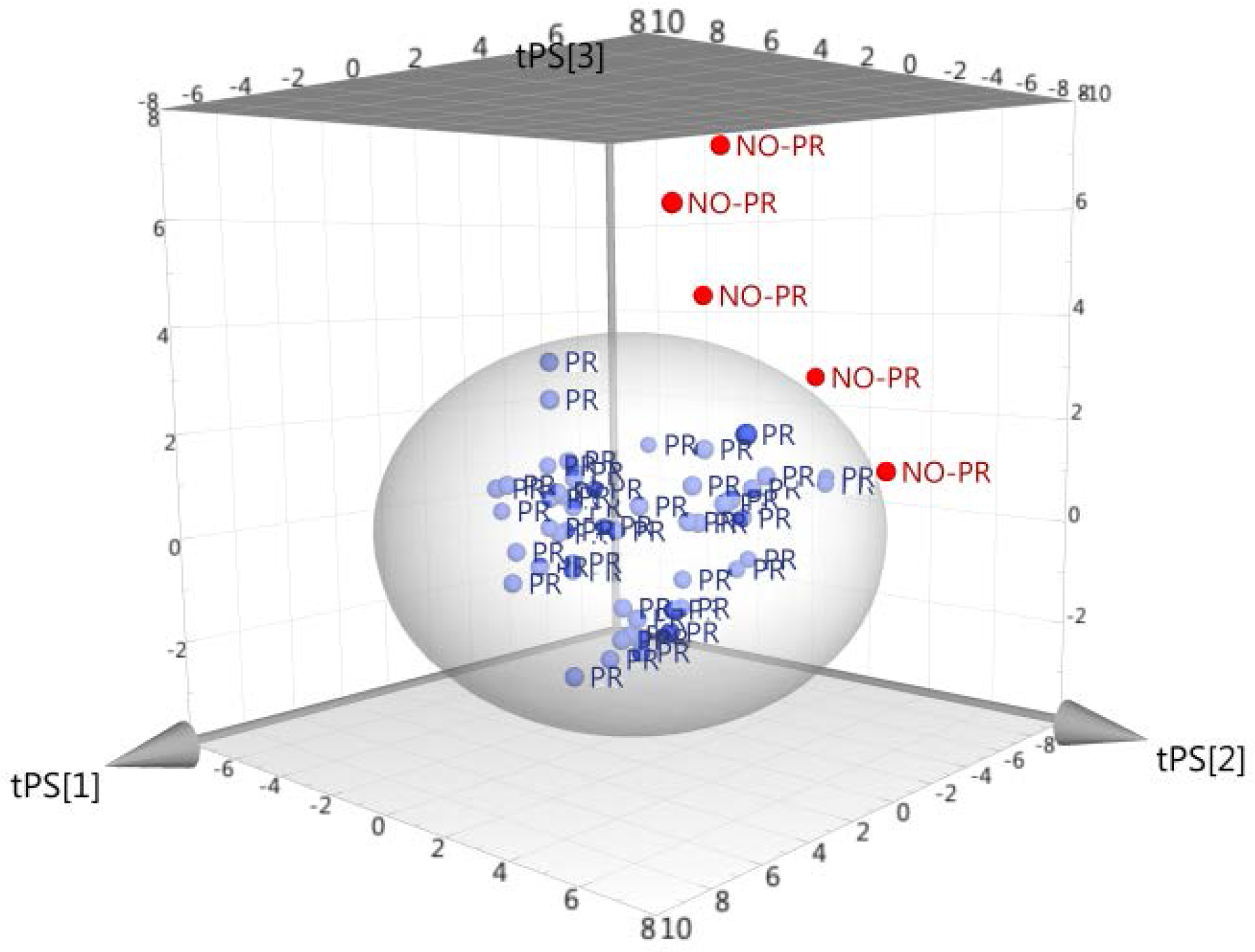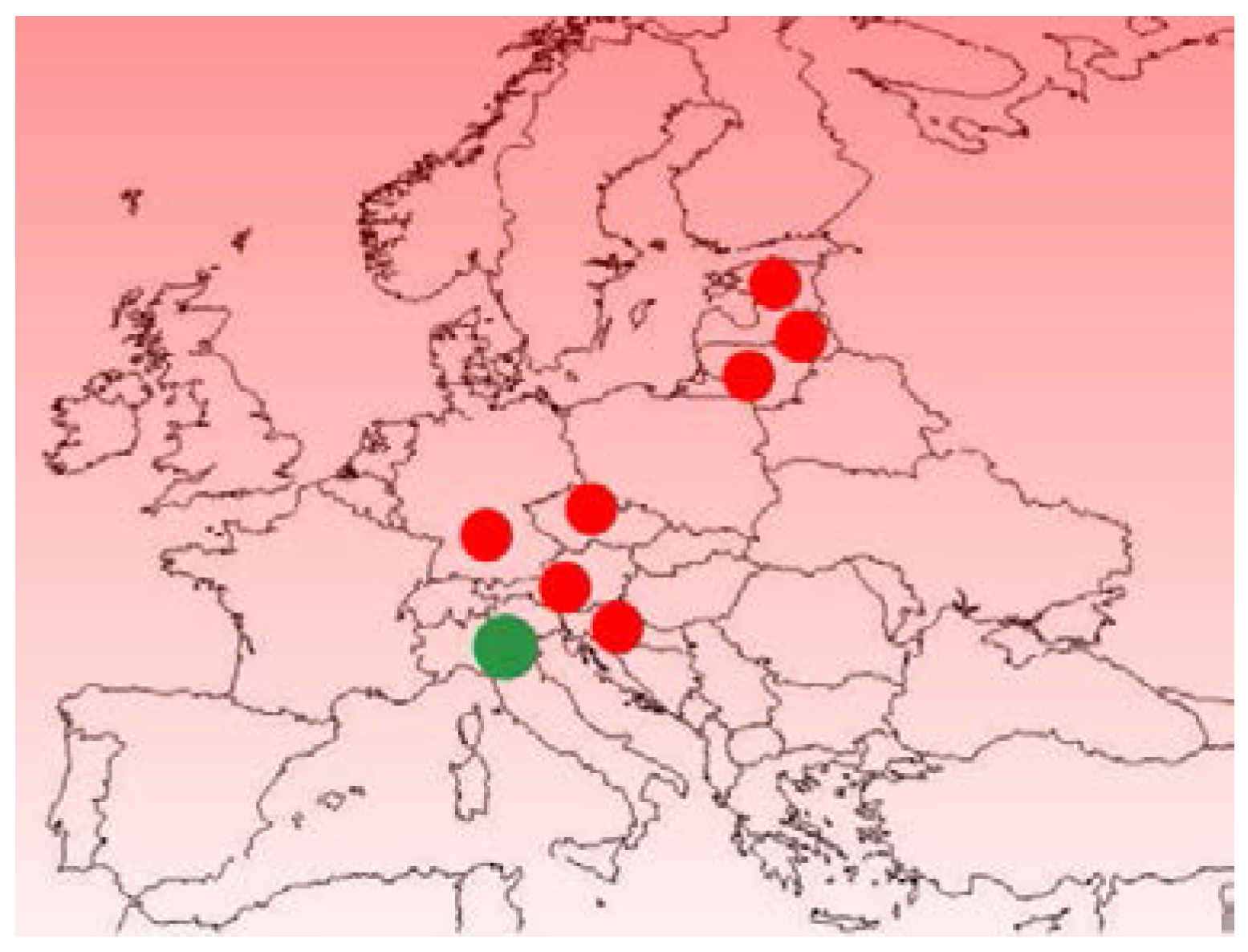Identification of the Geographic Origin of Parmigiano Reggiano (P.D.O.) Cheeses Deploying Non-Targeted Mass Spectrometry and Chemometrics
Abstract
:1. Introduction
2. Materials and Methods
- (1)
- the inclusion of two quality control samples (pool of 52 reference samples), which were already represented in the database, allowing us to dynamically monitor and verify variations (see Figure 1);
- (2)
- matrix-matched internal standard calibration for the quantitative evaluation of each compound;
- (3)
- the analysis of each sample in triplicate (including three individual extractions) to compensate for extraction variability;
- (4)
- the use of an internal standard to minimize the instrumental variability during the acquisition phase (see Figure 2).
3. Results
4. Discussion
5. Conclusions
Author Contributions
Conflicts of Interest
References
- United States Pharmacopeial Convention. USP Food Fraud Database. Available online: https://www.foodfraud.org/ (accessed on 2 January 2017).
- European Commission. Regulation (EC) No 178/2002 of the European Parliament and of the Council. Available online: http://eur-lex.europa.eu/LexUriServ/LexUriServ.do?uri=OJ:L:2002:031:0001:0024:en:PDF (accessed on 2 January 2017).
- European Commission. Regulation (EU) No 1169/2011 of the European Parliament and of the Council of 25 October 2011. Available online: http://eur-lex.europa.eu/legal-content/EN/ALL/?uri=CELEX%3A32011R1169 (accessed on 2 January 2017).
- European Commission. Regulation (EU) No 1151/2012 of the European Parliament and of the Council. Available online: http://eur-lex.europa.eu/LexUriServ/LexUriServ.do?uri=OJ:L:2012:343:0001:0029:en:PDF (accessed on 2 January 2017).
- European Commission. Regulation (EC) No 510-2006 of 20 March 2006. Available online: http://eur-lex.europa.eu/legal-content/EN/TXT/PDF/?uri=CELEX:32006R0510&from=EN (accessed on 2 January 2017).
- Rubert, J.; Zachariasova, M.; Hajslova, J. Advances in high-resolution mass spectrometry based on metabolomics studies for food—A review. Food Addit. Contam. Part A 2015, 32, 1685–1708. [Google Scholar] [CrossRef] [PubMed]
- Righetti, L.; Rubert, J.; Galaverna, G.; Folloni, S.; Ranieri, R.; Stranska-Zachariasova, M.; Hajslova, J.; Dall’Asta, C. Characterization and Discrimination of Ancient Grains: A Metabolomics Approach. Int. J. Mol. Sci. 2016, 17, 1217. [Google Scholar] [CrossRef] [PubMed]
- Rubert, J.; Lacina, O.; Zachariasova, M.; Hajslova, J. Saffron authentication based on liquid chromatography high resolution tandem mass spectrometry and multivariate data analysis. Food Chem. 2016, 204, 201–209. [Google Scholar] [CrossRef] [PubMed]
- Langford, V.S.; Reed, C.J.; Milligan, D.B.; McEwan, M.J.; Barringer, S.A.; Harper, W.J. Headspace Analysis of Italian and New Zealand Parmesan Cheeses. J. Food Sci. 2012, 77, C719–C726. [Google Scholar] [CrossRef] [PubMed]




| Sample Code | Sample Description | Theoretical Geographical Origin | Expected Classification | (Non Targeted MODEL)—PCA for Class | |
|---|---|---|---|---|---|
| Classification Score | Classification Result | ||||
| 15.539755.0001 | Parmigiano Reggiano (12 months) | North Italy | PR | 1.15 | PR |
| 15.539755.0002 | Riebekase | Outside North Italy | NO-PR | 2.83 × 10−15 | NO-PR |
| 15.539755.0003 | DzJugas | Outside North Italy | NO-PR | 6.66 × 10−15 | NO-PR |
| 15.539755.0004 | Grana Padano | North Italy | NO-PR | 2.52 × 10−4 | NO-PR |
| 15.539755.0005 | Parmigiano Reggiano (10 months) | North Italy | PR | 1.82 | PR |
| 15.539755.0006 | Parmigiano Reggiano (12 months) | North Italy | PR | 0.91 | PR |
| 15.539755.0007 | Parmigiano Reggiano (15 months) High Crust | North Italy | PR | 0.53 | PR |
| 15.539755.0008 | Grana Padano | North Italy | NO-PR | 0.94 | PR |
| 15.539755.0009 | Gran Moravia | Outside North Italy | NO-PR | 0.07 | NO-PR |
| 15.539755.0010 | Parmigiano Reggiano (12 months) | North Italy | PR | 1.82 | PR |
| 15.539755.0011 | Parmigiano Reggiano (15 months) High Fat | North Italy | PR | 1.21 | PR |
| 15.539755.0012 | Biraghi | North Italy | NO-PR | 1.40 | PR |
| 15.539755.0013 | Parmigiano Reggiano (12 months) Low Fat | North Italy | PR | 1.69 | PR |
| 15.539755.0014 | Parmigiano Reggiano (22 months) | North Italy | PR | 1.11 | PR |
| 15.539755.0015 | Parmigiano Reggiano (30 months) | North Italy | PR | 0.79 | PR |
| 15.539755.0016 | Parmigiano Reggiano (12 months) | North Italy | PR | 1.7 | PR |
| 15.544602.0001 | Parmigiano Reggiano | North Italy | PR | 0.29 | PR |
| 15.544602.0002 | Hartkase (Ger) | Outside North Italy | NO-PR | 3.26 × 10−21 | NO-PR |
| 15.544602.0003 | Grana Padano from Retailer | North Italy | NO-PR | 0.20 | PR |
| 15.544602.0004 | Parmigiano Reggiano | North Italy | PR | 0.63 | PR |
| 15.544602.0005 | Parmigiano Reggiano | North Italy | PR | 0.54 | PR |
| 15.544602.0006 | Parmigiano Reggiano | North Italy | PR | 0.60 | PR |
| 15.544602.0007 | Gran Biraghi | North Italy | NO-PR | 0.59 | PR |
| 15.544602.0008 | Parmigiano Reggiano | North Italy | PR | 0.92 | PR |
| 15.544602.0009 | Goya | Outside North Italy | NO-PR | 2.75 × 10−13 | NO-PR |
| 15.544602.0010 | German grated cheese | Outside North Italy | NO-PR | 0.16 | NO-PR |
| 16.552630.0001 | Lituania grated cheese | Outside North Italy | NO-PR | 1.35 × 10−9 | NO-PR |
| 16.552630.0002 | Parmigiano Reggiano | North Italy | PR | 3.47 | PR |
| 16.552630.0003 | Lettonia grated cheese | Outside North Italy | NO-PR | 1.23 × 10−3 | NO-PR |
| 16.552630.0004 | Lituania + German grated cheese | Outside North Italy | NO-PR | 1.77 × 10−3 | NO-PR |
| 16.552630.0005 | Estonia grated cheese | Outside North Italy | NO-PR | 1.26 × 10−14 | NO-PR |
| 16.552630.0006 | Parmigiano Reggiano | North Italy | PR | 8.16 × 103 | PR |
© 2017 by the authors. Licensee MDPI, Basel, Switzerland. This article is an open access article distributed under the terms and conditions of the Creative Commons Attribution (CC BY) license ( http://creativecommons.org/licenses/by/4.0/).
Share and Cite
Popping, B.; De Dominicis, E.; Dante, M.; Nocetti, M. Identification of the Geographic Origin of Parmigiano Reggiano (P.D.O.) Cheeses Deploying Non-Targeted Mass Spectrometry and Chemometrics. Foods 2017, 6, 13. https://doi.org/10.3390/foods6020013
Popping B, De Dominicis E, Dante M, Nocetti M. Identification of the Geographic Origin of Parmigiano Reggiano (P.D.O.) Cheeses Deploying Non-Targeted Mass Spectrometry and Chemometrics. Foods. 2017; 6(2):13. https://doi.org/10.3390/foods6020013
Chicago/Turabian StylePopping, Bert, Emiliano De Dominicis, Mario Dante, and Marco Nocetti. 2017. "Identification of the Geographic Origin of Parmigiano Reggiano (P.D.O.) Cheeses Deploying Non-Targeted Mass Spectrometry and Chemometrics" Foods 6, no. 2: 13. https://doi.org/10.3390/foods6020013





